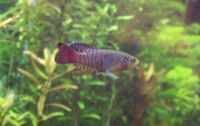Gunther's Killifish (Nothobranchius guentheri)
From The Aquarium Wiki
(Redirected from Gunther's Killifish)
Gunther's Killifish
Nothobranchius guentheri
19 Litres (5 US G.)
4.6-5.1cm (1.8-2 ")
Freshwater
7.0 - 8.0
22.2-25°C (72 -77 °F)
5-20 °d
1:2-3 M:F
1-2 years
Family
Nothobranchiidae
This animal is available captive bred
| You can contribute to the Aquarium Wiki by expanding this article. Dont be shy!. |
Contents
Additional names
- Gunther's Killifish, Redtail Notho, Guenther's Killifish
Native range[edit]
- Native to temporary bodies of water in Zanzibar. The adults all die during the dry season when these water bodies dry up; the eggs remain dormant in the substrate until the rains refill their habitat, at which point they hatch and reach maturity in as little as a month.
Tank compatibility[edit]
- This species is a habitual fin nipper, even of fishes with short fins like danios, and is best kept in a species tank. Males are hard drivers and are best outnumbered by females by at least two to one; in a small 5 gallon tank it is best to only keep a single male, though multiple males can be kept in larger tanks.
Tank setup[edit]
- Nothobranchius species in general are annual fishes with very short lifespans, and N. guentheri is no exception, rarely living more than 18 months even in captivity. Any fish keeper who intends to keep them long term needs to have a breeding setup to propagate this species; while many killifish hobbyists keep these fish in bare tanks with little more than a sponge filter, a heater, and a container of peat moss for spawning, there is no practical reason they cannot be kept in a properly decorated planted tank when they are not being spawned. Nothos in general need hard, alkaline water and become very vulnerable to velvet if kept in acidic water; many killifish keepers keep nothos in water with a significant amount of aquarium salt added to stave off velvet, but again this is not strictly necessary if good tank maintenance is followed. Like most killifishes, they are good jumpers and require a secure lid.
Diet[edit]
- Annual killifishes in general have high metabolisms and are best fed at least twice a day with live and frozen foods. This species will often accept dry foods, but these should not be their primary diet because they are not nutritious enough to support their high metabolism.
Sexing/reproduction[edit]
- The male is larger and far more colorful than the relatively plain, grey females. This is a true annual killifish whose eggs require a drying period to hatch; placing a container of peat moss, coconut coir, or similar material in a spawning tank will result in well conditioned fishes spawning in it. After a few days to a week of this, the substrate should be removed, partially dried so that it is moist but not still dripping wet, placed in a sealed (and ideally labelled) plastic bag, and left alone for 8-12 weeks. A skilled hobbyist can observe the fry's eyes within each egg when they are ready to hatch; otherwise just place a small amount of the media in water, and if fry are produced within 24 hours, wet the rest of the media. The newborn fry can take baby brine shrimp and microworms right away and can reach maturity in 4-5 weeks if conditions are good; fry are sensitive to water changes, and thus water changes - if performed - should be done carefully.
Notes[edit]
- Nothobranchius species have different needs than many other aquarium fishes, especially as far as breeding them is concerned, but the magnificent colors on the males more than repay those willing to exert the effort to care for them. This species is more forgiving than many members of its genus and is commonly recommended as a good beginner's killifish, especially for those just starting with annual killifishes. Note that incubation periods for the eggs vary widely between different annual fishes, even within the same genus; the incubation period can also vary based off temperature and ambient humidity.
Pictures[edit]
External links[edit]
- Fishbase (Mirrors:
 )
)
